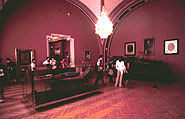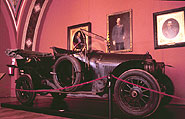


The Sarajevo exhibit is located on the first floor of the museum, in the wing to the right of the entrance. One enters from a hall devoted to the reign of Emperor Franz Joseph I (1848-1916), where displays show uniforms and weaponry of the Austrian army of the nineteenth and early 20th centuries. The room is approximately square, with a "Gothic" arched ceiling, is painted maroon, and is somewhat solemnly lighted by a chandelier in the center. The automobile is to one's right. On the wall behind it are three portraits of Archduke Franz Ferdinand.
The descriptive text placed before the automobile reads as follows:
Auto,
in dem der österreichische-ungarische Thronfolger General der Kavallerie und Admiral Erzherzog Franz Ferdinand von Österreich-Erste und seine Gemahlin, Herzogin Sophie von Hohenberg, am 28. Juni 1914 in Sarajewo ermordet worden.
Beschreibung:
Personenwagen Marke Graefe & Stift, Zulassungsnummer AIII-118. (Type: Doppel-Phaeton-Karosserie, 4 Zylinder, 115 mm. Bohrung, 140 mm Hub, 28/32 Ps-Leistung, Motor Nr. 287).
Der Wagen gehörte Franz Graf Harrach, der ihn als Angehöriger des freiwilligen Automobilkorps den Thronfolger für die Manöver im Juni 1914 zur Verfügung stellte und selbst an der Unglücksfahrt am 28. Juni 1914 teilnahm.
Translation:
Automobile,
in which the heir to the Austro-Hungarian throne, General of the Cavalry and Admiral, Archduke of Austria Franz Ferdinand I and his wife, Duchess Sophie von Hohenberg were murdered on June 28, 1914 in Sarajevo.
Description:
Passenger vehicle of the make Graefe & Stift, license number AIII-118 (Type: Double-Phaeton-Body, 4 Cylinder, 115 mm. bore, 140 mm. stroke, 28/32 horsepower, motor no. 287).
The vehicle belonged to Count Franz Harrach, who, as a member of the volunteer Automobile Corps provided it for the use of the Heir to the Throne for the manoeuvers in June 1914 and himself was a participant in the unfortunate journey on June 28 1914.
To the above one can add that the car was manufactured in 1910. Left of the windshield is a small banner with the insignia of the Archduke. There are still some bullet marks on the rear of the car, which was impounded after the assassination and then donated by its owner to Emperor Franz Joseph. The Emperor transferred it to the Imperial and Royal Army Museum, where it was displayed from 1914 to 1944. It was damaged in World War II and after being repaired moved to its current location in 1957.